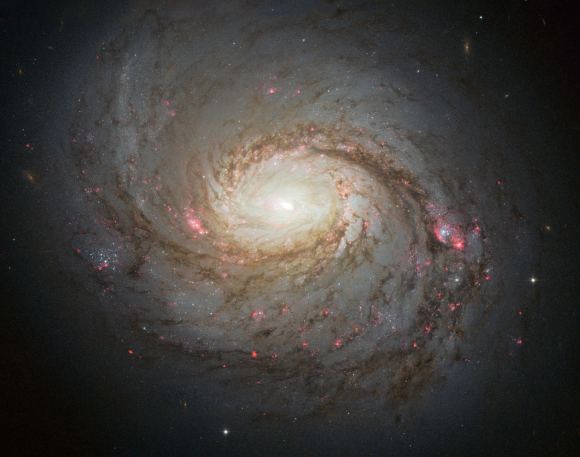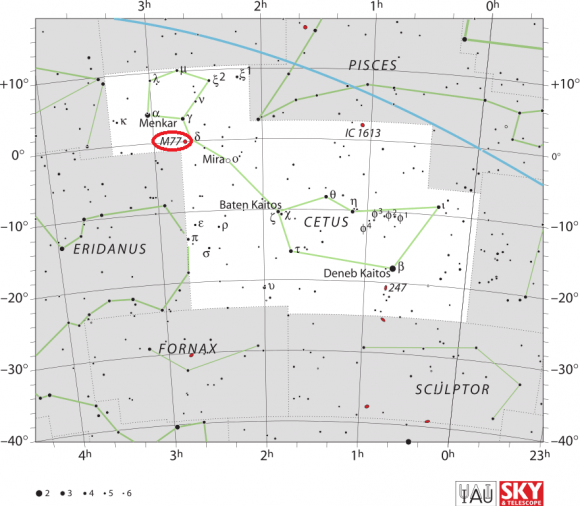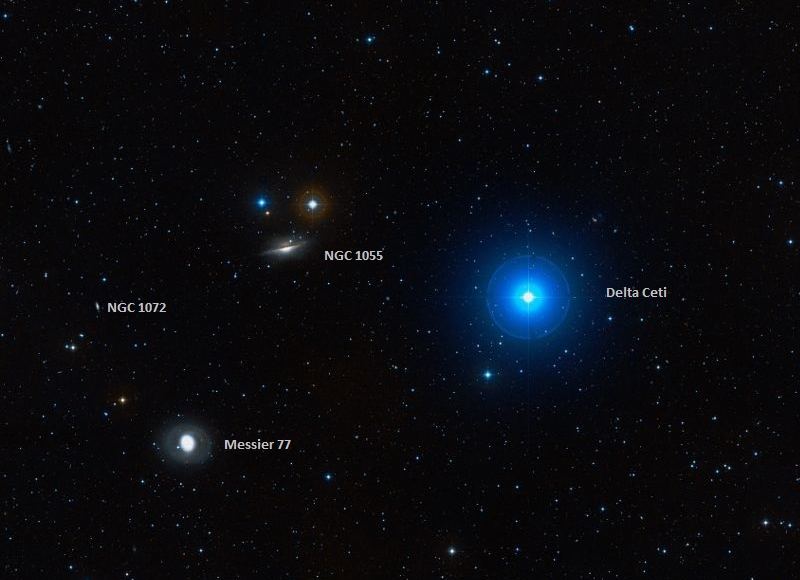Welcome back to Messier Monday! Today, we continue in our tribute to our dear friend, Tammy Plotner, by looking at Cetus A, the barred spiral galaxy known as Messier 77!
During the 18th century, famed French astronomer Charles Messier noticed the presence of several “nebulous objects” while surveying the night sky. Originally mistaking these objects for comets, he began to catalog them so that others would not make the same mistake. Today, the resulting list (known as the Messier Catalog) includes over 100 objects and is one of the most influential catalogs of Deep Space Objects.
One of these objects is known as Messier 77 (aka. Cetus A), a barred spiral galaxy located 47 million light-years from Earth in the constellation Cetus. Measuring some 170,000 light-years in diameter, it is one of the largest galaxies included in the Messier Catalog. Its size and bright core also make it relatively easy to spot with binoculars or small telescopes.
Description:
Located about 60 million light years away from our solar system and speeding away from us at 1100 kilometers per second, this grand galaxy could cover as much expanse as 170,000 light years at its extremities. That’s almost double the size of the Milky Way! Its broad spiral arms hold more evolved yellow stars like our own Sun, but towards the core beats the heart of a new generation – a young stellar population.

According to spectral analysis, Messier 77 has very broad emission lines, indicating that giant gas clouds are rapidly moving out of this galaxy’s core, at several hundreds of kilometers per second. This makes M77 a Seyfert Type II galaxy – one with an expanding core of starbirth. In itself, that’s quite unique considering the amount of energy needed to expand at that rate and further investigations found a 12-year diameter, point-like radio source at its core enveloped in a 100 light year swath of interstellar matter.
A miniature quasar? Perhaps… But whatever it is has a measurement of 10 million solar masses! As A.J. Young (et al) indicated in a 2001 study:
“We report sub arc-second resolution X-ray imaging-spectroscopy of the archetypal type 2 Seyfert galaxy NGC 1068 with the Chandra X-ray Observatory. The observations reveal the detailed structure and spectra of the 13 kpc-extent nebulosity previously imaged at lower resolution with ROSAT. The Chandra image shows a bright, compact source coincident with the brightest radio and optical emission; this source is extended b y ~160 pc in the same direction as the nuclear optical line and radio continuum emission. Bright X-ray emission extends ~500 pc to the NE and coincides with the NE radio lobe and gas in the narrow line region. The large-scale emission shows trailing spiral arms and other structures. There is a very strong correlation between the X-ray emission and the high excitation ionized gas seen in HST and ground-based [0 III] images. Spectra have been obtained for the nucleus, the bright region ~400 pc to the NE and 8 areas in the very extended emission. The spectra are inconsistent with hot plasma models. Models involving smooth continua plus emission lines provide excellent descriptions of the spectra The emission lines cannot be uniquely identified with the present spectral resolution but are consistent with the brighter lines seen in the XMM-Newton RGS spectrum below 2 keV> Hard X-ray emission, including an iron line, is seen extending 2.2 kpc NE and SW of the nucleus. Lower surface brightness, hard X-ray emission, with a tentatively detected iron line extends 5.5 kpc to the west and south. Our results, when taken together with the XMM-Newton RGS spectrum, suggest photo-ionization and fluorescence of gas by radiation from the Seyfert nucleus to several kpc from it. The starburst is not the dominant source of the extended X-rays.”
Is it possible the mass could be a black hole? Says W. Jaffe (et al) in a 2004 study:
“Active galactic nuclei (AGNs) display many energetic phenomena—broad emission lines, X-rays, relativistic jets, radio lobes—originating from matter falling onto a supermassive black hole. It is widely accepted that orientation effects play a major role in explaining the observational appearance of AGNs. Seen from certain directions, circum-nuclear dust clouds would block our view of the central powerhouse. Indirect evidence suggests that the dust clouds form a parsec-sized torus-shaped distribution. This explanation, however, remains unproved, as even the largest telescopes have not been able to resolve the dust structures. Here we report interferometric mid-infrared observations that spatially resolve these structures in the galaxy NGC 1068. The observations reveal warm (320 K) dust in a structure 2.1 parsec thick and 3.4 parsec in diameter, surrounding a smaller hot structure. As such a configuration of dust clouds would collapse in a time much shorter than the active phase of the AGN3, this observation requires a continual input of kinetic energy to the cloud system from a source coexistent with the AGN.”
So what else might be hiding in there? According to L. S. Nazarova of the Royal Greenwich Observatory; “The results of calculations of gas emission spectra with both central and extended sources of ionization have been compared to the ratio of line intensities observed in the extended narrow line region of NGC1068. The origin of an extended structure of anomalous strength in the [OIII] 5007 and [NeV] 3425 lines found by Evans and Dopita (1986) and Bergeron et al. (1989) could be due to an additional stellar source of gas ionization located at a distance 1–2 kpc from the nucleus.”
So where exactly is the famed nucleus? It isn’t quite as easy to find as you might think It requires detailed work using both optical and radio wavelengths. As Robin Catchpole (et al) explained in a 1996 study:
“NGC 1068 (M77) is the closest and brightest example of a Seyfert 2 galaxy. Many active galactic nuclei (AGN), including NGC 1068, have apparently conical or biconical high-excitation emission line structures extending from the position of the nucleus, which are taken as evidence of anisotropy and orientation effects evoked to explain the perceived differences between the various observationally classified AGN types. In this unifying hypothesis radiation is presumably collimated by an optically thick torus surrounding the nucleus. Whether a Seyfert galaxy of type 1 or 2 is seen depends on the orientation of the torus to the line of sight. The continuum radio map at 4.9 GHz obtained shows a double-lobed radio jet centered on the nucleus with a projected length of 6 to the north-east and about 10 to the south-west. Muxlow et al. (1996) have identified a faint source in their 5 GHz 60 mas resolution map which they believe to be the nucleus of NGC 1068 on the basis of its spectral slope.”
History of Observation:
I wonder if Pierre Mechain even had a clue on October 29, 1780 when he first saw this incredible spiral galaxy if there were such a science going on behind it. Messier looked at it, but did not record it. In this circumstance, Mechain did: “Cluster of small stars, which contains some nebulosity, in Cetus and on the parallel of the star Delta, reported of the third magnitude, and which M. Messier estimated to be hardly of the fifth. M. Mechain saw this cluster on October 29, 1780 in the form of a nebula.” (However, do not fault Messier for lack of interest at this time. His wife and newly born son had just died and he was mourning.)
In 1783, Sir William Herschel saw it as an “Ill defined star surrounded by nebulousity.” but would change his tune some 8 years later when he reported: “A kind of much magnified stellar cluster; it contains some bright stars in the centre.” His son, John Herschel, would go on to catalog it – not being very descriptive either. However, Admiral Smyth to the rescue!
“A round stellar nebula, near Delta in the Whale’s lower jaw, and about 2 1/2 deg from Gamma on the line towards Epsilon, or s. by w. This was first classed by Messier in 1780 as a mass of stars containing nebulosity. It is small, bright, and exactly in a line with three small stars, one preceding and two following, of which the nearest and largest is a 9th-magnitude to the south following east. There are other minute companions in the field; and the place is differentiated from Gamma Ceti. This object is wonderfully distant and insulated, with presumptive evidence of intrinsic density in its aggregation; and bearing indication of the existence of a central force, residing either in a central body or in the centre of gravity of the whole system. Sir William Herschel, after repeatedly examining it, says, – “From the observations of the large ten-feet telescope, which has a gauging power of 75.82, we may conclude that the profundity of the nearest part is at least of the 910th order.” That is, the 910 times as far off as the stars of the first magnitude!”
May your own observations be a little more… on??
Locating Messier 77:
M77 can be easily found less than a degree east/southeast from the 4th magnitude Delta Ceti. This magnificent face-on spiral galaxy can be spotted with smaller binoculars from a dark sky location as a round contrast change and is easily seen in small telescopes. As aperture increases, so does detail and high magnification works well with this galaxy. When at culmination, M77 is bright enough to withstand some urban sky pollution and the first stages of moonlight!

Object Name: Messier 77
Alternative Designations: M77, NGC 1068
Object Type: Sb Barred Spiral Galaxy
Constellation: Cetus
Right Ascension: 02 : 42.7 (h:m)
Declination: -00 : 01 (deg:m)
Distance: 60000 (kly)
Visual Brightness: 8.9 (mag)
Apparent Dimension: 7×6 (arc min)
We have written many interesting articles about Messier Objects and globular clusters here at Universe Today. Here’s Tammy Plotner’s Introduction to the Messier Objects, M1 – The Crab Nebula, Observing Spotlight – Whatever Happened to Messier 71?, and David Dickison’s articles on the 2013 and 2014 Messier Marathons.
Be sure to check out our complete Messier Catalog. And for more information, check out the SEDS Messier Database.
Sources:

